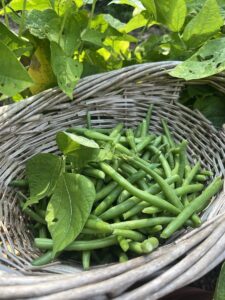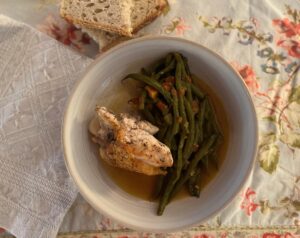I had a lot of things for the first time in college. Sex, for example — that was a keeper. And bagels. We didn’t have bagels where I grew up. Or so I thought. Later, my friend Charisse told me they were a secret only some families knew about. Another new experience for me then was being served a pile of lightly blanched green beans. They were supposed to be posh, but to me they seemed even weirder than bagels; they just seemed raw.

I grew up eating from and playing in the ruler-straight rows of my grandfather’s enormous kitchen garden. Planted as insurance against hunger long after such a thing was necessary for his household, it wrapped around the south side of their little white clapboard house, taking up much more space than their lawn did. From March until Christmas, we had a steady stream — actually, more like a mighty river — of lettuces, cucumbers, onions, tomatoes, eggplants, cabbages, peppers, squashes, purple-hull peas, snap beans (you probably call them green beans), and the hot chili peppers Pa liked to eat with his meals.
My grandmother couldn’t cook everything he grew or give it away fast enough. I’m guessing the abundance was a combination of fertile soil and the effects of the fertilizers my grandfather lavished on his garden. He liked his vegetables big. In 1972 the Eunice Daily News ran a photo of the 21-pound cabbage that was his pride and joy that year.
We had garden vegetables for dinner (what you call lunch) every day. And my favorite dish was and still is snap beans.
Never in her life did my grandmother serve a squeaky, grassy, blanched snap bean — or any other lightly cooked vegetable for that matter. When she cooked vegetables, they knew they were being cooked. What she served were pots of browned-then-braised green beans or squash or cabbage. They may not have been ready for a beautiful crudités photo shoot, but they were delicious. The caramelization and long cooking time drew out the sweetness of the beans that turned out tender and swam in a luscious pot-liquor we called liquid gold. It was perfect for spooning over rice or sopped up with crusty bread.

Done this way, beans lose their rigid greenness and relax into a deeper, more luxurious shade, and the heat coaxes out their hidden sweetness. The result is rich and densely flavored. This is not just a Louisiana thing or a Southern thing. The cuisines of India, Italy, Greece, Turkey, and other countries of the Mediterranean, Middle East, and North Africa all recognize the magic of cooking vegetables for a long time.
My favorite summer crop has been robust this year. That means pots of braised snap beans are on the menu. Perhaps braising sounds counterintuitive in the summer kitchen. But the method is easy and takes very little tending over low heat. The result is delicious served at room temperature, making these beans perfect as a make-ahead summer lunch or as a side dish at supper.
For this recipe you want hefty green beans, almost as thick as a pencil. There are two ways to take the recipes that were popular where I grew up. In one, the beans are cooked with new potatoes in a broth flavored with salted or smoked pork, though you could certainly leave out the pork and still have something wonderful. The other omits the potatoes and instead includes tomatoes and herbs. This recipe calls for diced peppers and celery, but if you don’t have those on hand, proceed anyway. Garlic and onion are, however, nonnegotiable.

The garlic and onion powders may seem either anachronistic or redundant, but I’ve started fortifying fresh onions and garlic with their dried versions in stewed dishes because I find that it deepens the flavors — the one-two punch of fresh and dried is a trick I learned from chef Eric Kim.
So, sure, blanch your earliest, thinnest haricots verts, give them an ice bath, and serve them dressed with some salt and good olive oil on top of a bed of freshly harvested salad greens. Essentially, you’re enjoying them raw, and that’s fun at first. But as the summer stretches out and the piles of vegetables grow, give in and cook the vegetables low and slow. You’ll learn what vegetable luxury really is.
BRAISED SNAP BEANS
Makes about 6 servings
For the beans with potatoes
3 Tbsp. bacon drippings or oil
¼ lb. salt pork or smoked ham, diced
1 lb. fresh green beans, trimmed
1 cup diced onions
½ cup diced red bell pepper
½ cup diced celery
2 garlic cloves, minced
½ tsp. garlic powder
½ tsp. onion powder
1 bay leaf
¼ tsp. salt
¼ tsp. black pepper
1½ cups chicken or vegetable stock
½ tsp. sugar
A few drops Crystal or other hot sauce (or to taste)
1 lb. peeled new potatoes, or larger potatoes peeled and cut into 1½-inch chunks
Chopped parsley and scallions for the garnish
For the beans with tomatoes
Omit the potatoes and substitute 2 large garden tomatoes, peeled, cored, and chopped, and 3 or 4 sprigs of thyme. Garnish the finished dish with chopped mint and parsley and a spritz or two of fresh lemon juice.
- If using the salt pork or ham, sauté it in the bacon fat or oil in a large saucepan over medium-high heat until browned and crisp.
- Add the beans to the pan and continue to sauté until they begin to brown, about 10 minutes.
- Add the onions, pepper, celery, garlic, garlic and onion powders, bay leaf, salt, and pepper and continue to sauté until the onions are translucent, about 3 minutes.
- Add the chicken stock or vegetable broth, the sugar, and the hot sauce and bring to a simmer.
- For the tomato version: add the tomatoes now, reduce heat to medium-low and simmer, partially covered, stirring occasionally, until the beans are tender, about 45 minutes to an hour. Add enough stock or water to the pot to keep the beans mostly covered. Cook another 15-30 minutes — the beans should be very soft but still hold their shape. Garnish with chopped mint and parsley and a spritz of lemon juice and serve with rice or crusty bread.
- For the potato version: reduce heat to medium-low and simmer, partially covered, stirring occasionally, until the beans are tender, about 30 minutes. Add enough stock or water to the pot to keep the beans mostly covered and add the potatoes. Partially cover the pot and continue to simmer until the potatoes are cooked through, about 30 minutes. Garnish with scallions and parsley and serve with rice or crusty bread.



